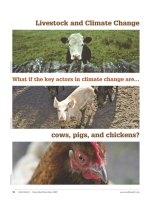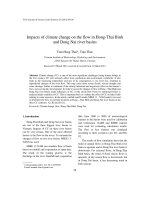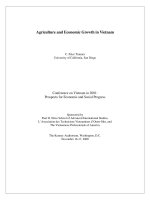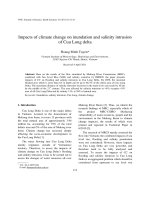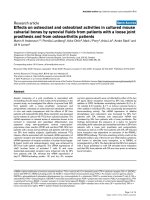Impact of climate change on agriculture and allied activities in Jagatsinghpur district of Odisha, India
Bạn đang xem bản rút gọn của tài liệu. Xem và tải ngay bản đầy đủ của tài liệu tại đây (245.99 KB, 6 trang )
Int.J.Curr.Microbiol.App.Sci (2019) 8(9): 921-926
International Journal of Current Microbiology and Applied Sciences
ISSN: 2319-7706 Volume 8 Number 09 (2019)
Journal homepage:
Original Research Article
/>
Impact of Climate CHANGE on Agriculture and Allied Activities in
Jagatsinghpur District of Odisha, India
Debasmita Nayak*, Mita Meher, Sushree Purabi Panigrahi and S.P Sangramsingh
Department of Extension Education, College of Agriculture, OUAT, India
*Corresponding author
ABSTRACT
Keywords
Climate,
Agriculture,
Sowing, Spacing,
Land preparation,
Straw yield,
Irrigation, Disease
infestation,
Pesticide and insect,
Pest infestation
Article Info
Accepted:
15 August 2019
Available Online:
10 September 2019
Agriculture and climate change are inextricable. Crop yield, biodiversity, water
use, and soil health are directly affected by the impact of climate change. Tropical
countries are likely to be more affected compared to temperate countries. The
brunt of environmental changes in India is very high due to higher dependence on
agriculture. Such a study would contribute towards a better understanding of the
intensity and impacts of the climate change. The research study was conducted in
Jagatsinghpur district of Odisha taking 120 respondents from Tirtol and
Raghunathpur block. From the study it was observed that 53.33% of respondents
solely depend on agriculture. The study revealed that 58.33%, 55.83%, 54.16%,
54.16%, 53.33 % of the respondents observed negative impact on sowing time,
spacing, grain yield quantity, straw yield and land preparation respectively.
44.16%, 40.83%, 40.83%, 39.16% felt increasing of number of irrigation, Disease
infestation, pesticide use, and insect, pest infestation respectively. 49.16 %
observed no effect on disease infestation, number of irrigation and pesticide use.
Introduction
Climate change is one of the biggest
environmental issues facing the world today.
Climate change refers to any change in
climate, whether due to natural variability
and/or as a result of human activity (1,2).
There are already increasing concern globally
regarding climate change that affects the
environment and livelihood. Now a days most
of the countries are facing the problems of
rising temperature, rising sea level, changes in
precipitation patterns etc. Climate change
effects can be measurable in different degrees,
at different times and with a varying intensity
depending on the region and sector of the
economy. Predicting future impact is therefore
difficult but this inherent complexity must not
prevent immediate attempts to do so together
with an understanding of the magnitude of
uncertainty.
Agriculture
and
forestry
production will be affected directly by the
climate change (3,4). The resources and
ecosystem services will also be affected: soil,
921
Int.J.Curr.Microbiol.App.Sci (2019) 8(9): 921-926
water, pollination, nutrient cycling, genetic
resources and biodiversity. Adaptation
strategies should be introduced in response to
climate change to reduce negative effects and
exploit potential positive ones.
According to the assessment by the EEA,
European Commission, OECD, the World
Wide Fund for Nature, IUCN, and various UN
bodies for Europe, in many regions there is
increase in irrigated area and water abstraction
for irrigation. In the northern temperate region
agro-climatic zones are likely to move
northwards as a result of climate change. In
the southern areas, current crop areas may be
abandoned due to very low availability of
water (5,6,7).
The impact of climate change on agriculture is
severely felt in India. It has been predicted
that under the scenario of a 2.5°C to 4.9°C
temperature will rise, rice yields will drop by
32%-40% and wheat yields by 41%-52%. This
will cause the GDP to fall by 1.8%-3.4%.
Understanding on global climate and its
change is pre requisite to take appropriate
initiatives to combat climate change. The only
solution for these huge populations seems to
be adequate adaptation strategies.
Materials and Methods
Research methodology refers to the structural
configuration of the study for conducting
research within the frame work of the
objectives. It includes different types of
methods, tools, techniques and approaches for
any research work. Moreover, research
methodology is concerned with the objective
verification which requires logical analysis of
problems and devising appropriate procedure
to obtain evidence.
A research design is defined as the programme
that guides the researcher in the process of
collecting,
analysing
and
interpreting
observations to draw inferences. The present
study comes within the purview of survey
research mainly to ‘Ex-post facto in nature.
For the present study we had selected two
blocks Tirtol and Raghunathpur from the 8
blocks of Jagatsinghpur district by random
sampling method. Then we had selected 8
villages (4 from each block). In the study we
had taken the views of 120 farmers who were
selected through disproportionate random
sampling method from the 8 villages (15 from
each village). We had conducted a pilot study
and also pre testing of the interview schedule
was done taking 10% of the total respondents
i.e. 12 number of respondents.
Personal interview and focused group
discussion techniques were followed for
collection of information. Different statistical
tools like percentage, frequency were
followed.
Results and Discussion
Socio-economic characteristics of farmers
The socio-personal characteristics are defined
on the basis of personal, social, economic
characters. Respondents were categorized and
their frequency and percentage was calculated
for further analysis. From this study it is
observed that most of the respondents i.e. 40%
belong to middle aged category while 38.33%
were old aged and 21.66% were young.
The findings reveal that the majority of
respondents 34.16% were high school pass out
where 7.5%, 13.33%, 21.66%,23.33% were
illiterate, could read and write, primary school
pass out and college pass out respectively.
As regards the family type, it has been
observed that most of the respondents 56.66%
belong to the joint family where 43.33%
belong to nuclear family.
From this study it is observed that most of the
922
Int.J.Curr.Microbiol.App.Sci (2019) 8(9): 921-926
respondents (45.83%) have 20-40 years of
experience while 30% have upto 20%
experience and 24.16% have more than 40%
experience.
Further, the land holding of the farmers reveal
that that most of the respondents i.e 60% of
the respondents have upto 1 hac of land and
34.16 % and 5.83 % of the respondents have
1-2 hac land and > 2 hac land respectively.
The findings about family income reveal that
majority of respondents (40%) have annual
income of Rs. 20000-Rs 40000 while 33.33%,
15% and 11.66% have Rs. 40000-60000, >Rs
60000 and below Rs. 20000 respectively.
Table.1 Distribution of the respondents according to their socio economic characteristics
(n=120)
Characteristics
Category
Frequency
Percentage
Age
Upto 35years
26
21.67
36-50 years
48
40
> 50 years
46
38.33
Illiterate
9
7.5
Read and write
16
13.33
Primary school
26
21.67
High school
41
34.16
College and above
28
23.34
Nuclear
52
43.33
Joint
68
56.67
20 years
36
30
20-40 years
55
45.84
>40 years
29
24.16
Upto 1 hac
72
60
1-2 hac
41
34.16
< 2 hac
7
5.84
Upto Rs20000
14
11.66
Rs20000-40000
48
40
Rs 40000-60000
40
33.34
>Rs 60000
18
15
Education
Family type
Farming experience
Land holding
Annual income
923
Int.J.Curr.Microbiol.App.Sci (2019) 8(9): 921-926
Table.2 Distribution of respondents according to their view on impact of climate change on
agriculture (n=120)
Sl. No.
Farming practices
Effect of climate change
Positive
Negative
No Effect
F
P
F
P
F
P
1
Soil fertility
12
10
64
53.33
44
36.6
2
Crops grown
15
12.5
45
37.5
60
50
3
Cropping pattern
18
1512.5
48
40
54
45
4
Variety selection
15
12.5
45
37.5
60
50
5
Land preparation
12
10
64
53.33
44
36.6
6
Sowing time
8
6.66
70
58.33
42
35
7
Spacing
13
18.3
67
55.83
40
33.33
8
Seed treatment
10
8.33
12
10
98
81.66
9
FYM application
20
16.66
22
18.33
78
65
10
Use of chemical fertilizers
39
32.5
25
20.83
56
46.66
11
Time of application
11
9.16
10
8.33
99
82.5
12
Intercultural operations
40
33.33
32
26.66
48
40
13
Weed growth
20
16.66
58
48.33
42
35
14
Insect, pest infestation
47
39.16
10
8.33
63
52.5
15
Disease infestation
49
40.83
12
10
59
49.16
16
Pesticide use
49
40.83
12
10
59
49.16
17
No. of irrigations
53
44.16
8
6.66
59
49.16
18
Harvesting
23
19.16
48
40
49
40.83
19
Grain yield quality
10
8.33
60
50
50
41.66
20
Grain yield quantity
5
4.16
65
54.16
50
41.66
21
Straw yield
6
5
65
54.16
49
40.83
22
Storage
22
18.33
22
18.33
76
63.33
23
Market price
39
32.5
31
25.83
50
41.66
24
Overall health of the crop
12
10
62
51.66
46
38.33
25
Shelf life of the crop
8
6.66
64
53.33
48
40
26
Storage pests and diseases
50
41.66
12
10
58
48.33
27
Taste of the produce
7
5.83
69
36.66
44
36.66
28
Any other
21
17.5
40
33.33
59
49.16
924
Int.J.Curr.Microbiol.App.Sci (2019) 8(9): 921-926
Table.3 Distribution of respondents according to their view on impact of
climate change on allied activities (n =120)
Sl no
STATEMENTS
1
Species of some animal
and bird has extinct
Scarcity of fodder in the
area
Behavioural changes and
adverse effect on health of
livestock
New fish species found
and old species have
extinct in rivers
Pollutions are increasing
2
3
4
5
AGREE
F
P
81
67.5
DISAGREE
F
P
14
11.67
CAN’T SAY
F
P
25
20.83
84
70
14
11.67
22
18.33
69
57.5
13
10.84
38
31.66
66
55
8
6.67
46
38.33
86
71.67
0
0
34
28.33
From this table it is observed that most of the
respondents 71.66% felt that pollutions are
increasing due to climate change. 70%,
67.5%, 57.5%, 55% experienced scarcity of
fodder, extinction of species, adverse effect
on livestock, effect on fishes as the impact of
climate change.
Impact of climate change on agriculture
Climate change impact and associated
vulnerabilities are of particular to developing
countries where large parts of the population
depend on climate sensitive sectors like
agriculture for livelihood. Impact of climate
change at local level is difficult to assess due
to poor understanding of microclimate. Most
of the farming communities cannot classify
the concept climate change but are good at
describing changes in weather and its impact.
Farmers were asked about changes occurred
in agriculture and allied activities according
to their past experiences as impact of climate
change.
In the study area the respondents viewed
pollution and scarcity of fodders as most
serious impact of climate change.
Summary and conclusion are as follows;
Climate change will bring about changes in
weather patterns, river systems, crop yields
and impact people. Climate is closely related
to human and economic activities including
agricultural system. Some changes in climate
will affect agriculture through their direct and
indirect effects on crops, livestock, fisheries
etc. Tropical countries are likely to be
affected more as compared to the temperate
countries. The brunt of environmental
changes is expected to be very high in India
due to greater dependence on agriculture,
alarming increase in human and livestock
population, changing pattern in land use and
socio-economic factors that create a great
threat in meeting the food, fibre, fuel and
From the table it was observed that majority
of farmers 81.66% observed no effect on seed
treatment, 58.33%,
55.83%, 54.16%,
54.16%, 53.33 % observed negative impact
on sowing time, spacing grain yield quantity,
straw yield and land preparation respectively.
44.16%, 40.83%, 40.83%, 39.16% felt
increasing of number of irrigation, Disease
infestation, pesticide use, and insect, pest
infestation respectively. 49.16 % observed no
effect on disease infestation, number of
irrigation and pesticide use.
925
Int.J.Curr.Microbiol.App.Sci (2019) 8(9): 921-926
fodder requirement. The findings from the
study conclude that there was both positive
and negative impact of climate. 58.33%,
55.83%, 54.16%, 54.16%, 53.33 % observed
negative impact on sowing time, spacing
grain yield quantity, straw yield and land
preparation respectively where 18. 44.16%,
40.83%, 40.83%, 39.16% felt increasing of
number of irrigation, disease infestation,
pesticide use, and insect, pest infestation
respectively. In the study area most of the
respondents 71.66% felt that pollutions are
increasing due to climate change.
3.
4.
5.
6.
References
1. Akerman EK. 2010. Farmers' perception of
climate change and adaptation strategies
in Sub-Saharan West-Africa. 2nd
International Conference: Climate,
sustainability and development in Semiarid Regions August 16 - 20, 2010,
Fortaleza - Ceará, Brazil.
2. Bryan E, Deressa TT and Ringler C. 2009.
Adaptation to climate change in
7.
Ethiopia and South Africa, Options and
constraints. Environmental Science and
Policy, 12(4): 413-426.
DEA 2014. Climate change perceptions
and local adaptation strategies of hazard
prone rural household of Bangladesh,
climate risk management, volume 17,
Bangladesh.
Morton 2017. Assessing farmers’
perception about climate change,
climate risk management, 17, 123-138.
Ravishankar. 2013. A study on constraints
faced by Farmers in adapting to climate
change, Hum Ecol, 44:23-28, NDRI
Sarkar S and Padaria RN. 2010. Farmers’
awareness and risk perception about
climate change in Coastal Ecosystem of
West Bengal, Indian Research Journal
of Extension Education 10 (2): 32-38.
Shalander K, Raj BMK and B
Venkateswarlu. 2011. Sensitivity of
yields of major rainfed crops to climate
in India. Indian J. Agric. Econ., 66(3):
55-58.
How to cite this article:
Debasmita Nayak, Mita Meher, Sushree Purabi Panigrahi and Sangramsingh, S.P. 2019. Impact
of Climate CHANGE on Agriculture and Allied Activities in Jagatsinghpur District of Odisha.
Int.J.Curr.Microbiol.App.Sci. 8(09): 921-926. doi: />
926



